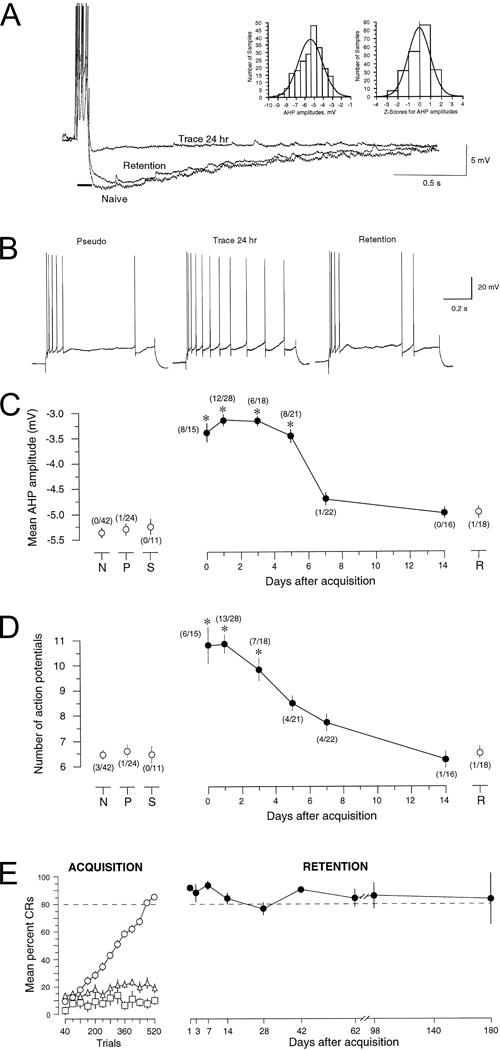Figure 3.

Acquisition of hippocampus-dependent trace eyeblink conditioning increased excitability of hippocampal CA1 pyramidal neurons. A: Voltage trace shows an overlay of recordings of the postburst AHPs in CA1 neurons from a naive (Naive) and from trace-conditioned rabbits studied 24 hr after initial learning (Trace 24 hr) or 24 hr after receiving an additional training session given 14 d after initial learning (Retention). The resting membrane potentials for these cells were approximately −66 mV, with action potentials truncated for visualization of the AHP. The AHP was measured for 5 sec beginning after a 100 msec depolarizing current injection (solid black line), with minimal current (~0.6 nA) required to reliably evoke a burst of four action potentials. The postburst AHPs from experimentally naive rabbits followed a normal distribution as shown in the frequency distribution and z-score graphs (insets). B: Examples of typical accommodation responses in CA1 pyramidal cells from rabbits: 24 hr after pseudoconditioning (Pseudo), 24 hr after acquisition of trace conditioning (Trace 24 hr), and 24 hr after receiving an additional training session 14 d after acquisition (Retention). Notice that although the cell from the trace-conditioned rabbit fired more action potentials, accommodation was certainly not abolished (as evidenced by the increase in interspike interval with time during the 800 msec depolarizing stimulus) but, rather, was significantly and transiently reduced after learning. Increased excitability of CA1 pyramidal neurons after learning was transient while performance remained persistent. C: Learning-related reductions of the AHP amplitude were transient, lasting ~1 week in slices prepared at various times after learning [1 hr (0 d), 1 d, 3 d, 5 d, 7 d, or 14 d]. Such changes were not observed in naive (N), pseudoconditioned (P), or slow-learning (S) control rabbits. Numbers in parentheses indicate the ratio of individual cells with reduced AHPs to number of cells studied in that group. Slow learners (S) were defined as rabbits that did not reach criterion within 15 training sessions, and that exhibited <30% conditioned responses on the last training session. Retention (R) rabbits received an additional 80-trial training session on the 14th day after initial learning. D: Trace eyeblink conditioning also resulted in a transient decrease in spike-frequency adaptation (accommodation) in CA1 neurons. Cells from slow-learning or pseudoconditioned control rabbits showed no changes, nor did cells from retention rabbits that received an additional training session 14 d later. The ratio of individual cells with reduced accommodation versus the number of cells studied for each group is indicated in parentheses. A cell was classified as having reduced accommodation if the number of APs elicited was at least 2 SDs more than the mean for all naive control cells. E: After successful acquisition, rabbits maintained the learned association. The left panel (ACQUISITION) shows the normalized learning curves for trace conditioned compared with pseudoconditioned and slow-learning rabbits. Trace-conditioned rabbits (○, n = 46) required an average of 7.1 ± 0.6 sessions to learn the task. As can be seen clearly, neither the pseudoconditioned (▵, n = 11) nor the slow-learning rabbits (□, n = 3) showed significant improvement across sessions. Thus, the pseudoconditioned and slow-learning rabbits served as excellent controls for nonspecific effects of training unrelated to associative learning. The right panel (RETENTION) shows the percent CRs elicited during 20 paired CS–US trials delivered at various time intervals after acquisition. Notice that when retention rabbits (•, n = 10) received 20 paired CS–US conditioning trials at the indicated times after learning, they maintained their criterion performance. For C and D, asterisks indicate data significantly different from all three control groups: *p < 0.001. Figure modified from Moyer, Thompson, and Disterhoft, J. Neurosci. 1996, 16:5536–5546.
